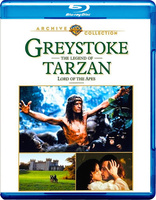Greystoke: The Legend of Tarzan, Lord of the Apes Blu-ray Movie
HomeGreystoke: The Legend of Tarzan, Lord of the Apes Blu-ray Movie 
Warner Archive CollectionWarner Bros. | 1984 | 137 min | Rated PG | Jul 16, 2013
Movie rating
7 | / 10 |
Blu-ray rating
| Users | 3.8 | |
| Reviewer | 4.0 | |
| Overall | 3.8 |
Overview
Greystoke: The Legend of Tarzan, Lord of the Apes (1984)
A shipwreck strands the heir to an English title and his wife in the wilds of 19th Century Africa, where the wife gives birth to a son. When both parents are killed, a female ape takes the tiny boy as a replacement for her own dead infant, and raises him. Twenty years later, an explorer, Capt. Phillippe D'Arnot discovers the man, who thinks he is an ape. Evidence left by the deceased parents reveals that the wild man is the direct descendant of the Earl of Greystoke, whom Capt. D'Arnot attempts to return to civilization.
Starring: Christopher Lambert, Andie MacDowell, Ralph Richardson (I), Ian Holm, James FoxDirector: Hugh Hudson
| Drama | Uncertain |
| Adventure | Uncertain |
| Romance | Uncertain |
Specifications
Video
Video codec: MPEG-4 AVC
Video resolution: 1080p
Aspect ratio: 2.40:1
Original aspect ratio: 2.39:1
Audio
English: DTS-HD Master Audio 5.1 (48kHz, 24-bit)
Subtitles
English SDH
Discs
50GB Blu-ray Disc
Single disc (1 BD)
Playback
Region free
Review
Rating summary
| Movie | 3.0 | |
| Video | 5.0 | |
| Audio | 4.0 | |
| Extras | 2.5 | |
| Overall | 4.0 |
Greystoke: The Legend of Tarzan, Lord of the Apes Blu-ray Movie Review
Don't Call Me Tarzan
Reviewed by Michael Reuben July 29, 2013There's nothing wrong with Greystoke: The Legend of Tarzan, Lord of the Apes that couldn't be fixed by a different script and better direction. Despite a publicity campaign trumpeting the film's fidelity to the original writings of Edgar Rice Burroughs, Greystoke took its own liberties with Burroughs' character. Perhaps its gravest departure was more in tone than event. The director, Hugh Hudson, is best known for 1981's Best Picture winner Chariots of Fire. Hudson attempted to endow the "origin story" of Burroughs' ape man with the same epic sweep and operatic grandeur he'd brought to his earlier saga of Olympic runners, but in the process he lost touch with the pulp essence that gives Burroughs' adventure tales their enduring appeal. Rescuing Tarzan from Johnny Weissmuller's Thirties film caricature of a noble savage is one thing. Making him Hamlet in the rain forest is quite another. The original screenwriter, Robert Towne (Chinatown), insisted that he be credited with the name of his dog, "P.H. Vazak". According to one account, Towne was displeased with rewrites demanded by Hudson. (A second screenwriter is also listed, Michael Austin, whose major subsequent credit is as writer and director of the little-seen Princess Caraboo.) In another account, Towne's fury resulted from his being replaced as Greystoke's director, after the box office failure of his directorial debut, Personal Best (1982). Whether or not Hudson used Towne's original script, he created a film that looked good, but meandered episodically, Curiosity and the devotion of long-time Tarzan fans drew enough of an audience to sell just under $49 million in tickets, which was a respectable showing for 1984 but hardly a blockbuster. Greystoke has been such a weak performer on home video that the Blu-ray is being issued through the Warner Archive Collection.
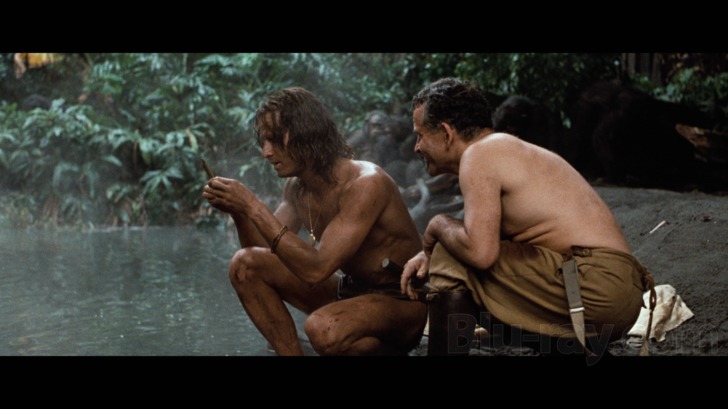
Note: The version of Greystoke released on Blu-ray is the same "extended" version that Warner Home Video has provided since 1992, which is roughly six minutes longer than the cut originally released to theaters. A list of the changes can be found here at IMDb. The commentary by director Hugh Hudson was recorded for this version, but it is unclear whether it constitutes a "director's cut". Greystoke falls into three acts. The first begins in 1885, when Lord John "Jack" Clayton (Paul Geoffrey) bids farewell to his father, the Sixth Earl of Greystoke (Ralph Richardson, in his last film) and sets sail for a tour of western Africa with his wife, Lady Alice (Cheryl Campbell). Jack and Alice narrowly survive a shipwreck off the equatorial coast, in which most of the passengers and crew perish. Captain Billings (Richard Griffiths) survives, and after a few months he departs on foot in search of help, leaving the Claytons on their own. He never returns. Alice Clayton gives birth to a son, but the delivery leaves her weak and vulnerable to malaria, from which she never recovers. Just as her husband realizes that Alice has passed away, their makeshift tree house is attacked by apes, and Jack is killed. The baby boy is rescued, however, by a female ape identified in the credits as Kala. (Like most of the ape characters, Kala is played by a human in a convincing suit designed by makeup genius Rick Baker.) In a prologue sequence added after the film's theatrical release, Kala is seen losing her own infant as her group flees an erupting volcano. She takes the Clayton child as a replacement and cares for him as her own. Believing himself to be an ape, the boy grows in size, strength and agility (he is played by a series of child actors: Peter Kyriakou, Danny Potts, Eric Langlois). He also learns the intricacies of ape society and the survival skills that the jungle requires. Greystoke's second act begins about twenty years after the birth of "Tarzan" (a name that is never uttered in the film) with the arrival of a Belgian explorer, Capitaine Phillippe D'Arnot (Ian Holm), who is accompanying a group of scholars sent by the British Museum. They find the tree house where the Claytons died. The moldering remains of Jack Clayton's journal reveal enough of their story to pique D'Arnot's curiosity, but then the explorers' party is attacked by a band of pygmy warriors. Injured and separated from the group, D'Arnot is rescued by an ape-like man (Christopher Lambert) whom D'Arnot instantly recognizes as the grown son of Lord Jack Clayton. As "Tarzan" nurses D'Arnot back to health surrounded by the ape clan of which he is now the leader, D'Arnot teaches the "white ape" the rudiments of language and a few essentials of civilization, such as shaving. Eventually, D'Arnot is able to convince the jungle creature that he has a whole other family waiting to see him out there, beyond where he can see. They set off together to seek passage to Scotland—a long and difficult journey, most of which happens off-screen. The portion that we do see demonstrates the peril, as they stop at an inn on the edge of civilization. The proprietor, Buller (David Suchet), and his regular clientele of reprobates, which includes Billings, the ship captain who abandoned the Claytons all those years ago, attack D'Arnot for no particular reason except that he's a stranger. "Tarzan" immediately beats them back—and burns down the inn for good measure. In the film's third act, "Tarzan", now called Johnnie by Lord Greystoke, returns to Scotland and an emotional welcome by his grandfather, who is overcome with joy at the discovery that a member of his family still lives. Equally pleased to see Johnny, and strangely moved by the man's odd manner, is Lord Greystoke's American ward, Jane Porter (Andie MacDowell, in her first film, with her Southern accent overdubbed by an uncredited Glenn Close). Though Jane is the object of Lord Charles Esker's (James Fox) attentions, he doesn't stand a chance once Johnny enters the picture. This is the longest portion of the film and, leaving aside various plot turns, the question that hangs over it is where Johnny truly belongs. Can he ever really adapt to the life of an English aristocrat? The question is implicit in the film's visual texture. After spending over an hour in the African jungle (with real location footage shot in Cameroon), the paintings, tapestries, wood paneling and elaborate fashions of Victorian Britain appear almost as incongruous to the viewer as they must to Johnny Greystoke. It's a relief to the eye, as it must be to the character, when he climbs to the roof of the ancestral manor for a sense of openness and air. The turning point for Johnny comes during the ceremonial dedication of a wing at the Natural History Museum endowed by the Greystoke family and dedicated to African flora and fauna. Johnny reacts to the specimens not as a member of the curious public but as an inhabitant of the wilds from which these animals were hunted and retrieved. His inadvertent discovery of a private research area triggers a crisis that leads to the film's conclusion. Regardless of who is responsible for the final shooting script of Greystoke, its fundamental failing is that it never draws the viewer close to its central character. This is not to fault Christopher Lambert's performance, which is impressive. Indeed, it may be too good. Lambert so successfully embodies the consciousness of someone who grew up without human language and thinks entirely in the present tense that he becomes almost opaque, a cypher. A film about "Tarzan" requires a central character who invokes the audience's interest, sympathy and concern, one who can make the viewer a participant in the story. But Greystoke doesn't give Lambert the resources with which to establish that kind of relationship with the viewer. The character moves from one extreme environment (the jungle) to another (a Scottish castle) without ever acquiring the purposeful trajectory that makes a character a true protagonist. Ian Holm's D'Arnot ends up stealing most of his scenes with Lambert, not so much because Holm is a great actor (which he is), but because D'Arnot has a clear arc that makes him more approachable as a character. Lambert gets no help from Hudson, whose stately visual compositions were sufficient for a film like Chariots, where the story was conveyed in dialogue, but who falls short when he has to sustain a narrative on images alone. For long stretches of Greystoke's first two acts, Hudson has to tell Tarzan's tale without human language, as first the boy and then the man interacts with ape society in grunts, screeches and gestures. Critical events occur during these passages, and conveying them with clarity requires precise control over visual storytelling. Hudson too often loses the thread. After seeing the film several times, and especially after listening to Hudson's commentary, you can sort out events, but a Kubrick or a Spielberg would have gotten it right on the first viewing. In filmmaking, story should come first, pretty pictures second.
Greystoke: The Legend of Tarzan, Lord of the Apes Blu-ray Movie, Video Quality 
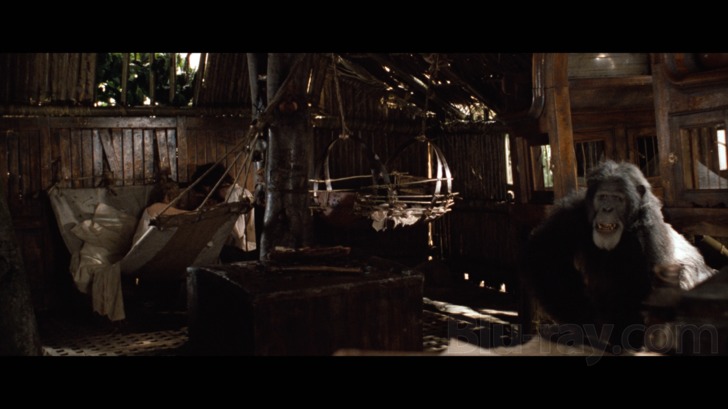
The Warner Archive Collection (WAC) twice postponed Greystoke to put more work into the transfer and mastering, and they certainly made good use of the additional time. The late John Alcott, an Oscar winner for Barry Lyndon, did most of the cinematography, with uncredited additional work by David Watkin. According to Hudson, it was Alcott who figured out a way to get exposures deep in the jungles of Cameroon, where almost no light penetrated. WAC's 1080p, AVC-encoded Blu-ray has been taken from what appears to be pristine sources that have been scanned and color-corrected with care and precision. Detail is abundant, whether in the trees and vines of the jungle or in the equally entangling thicket of antique furnishings and social protocol at Castle Greystoke. The blacks are excellent, which is crucial both for dark passages in the wild and for formal wear in civilization, and colors, especially the rich jungle greens, are vividly rendered. A natural but unobtrusive grain pattern can be observed throughout the frame, and there is no evidence of filtering, artificial sharpening or other untoward digital manipulation. The unusually high average bitrate of 34.71 Mbps no doubt contributes greatly to the exceptional image quality and certainly explains the lack of any compression-related anomalies.
Greystoke: The Legend of Tarzan, Lord of the Apes Blu-ray Movie, Audio Quality 
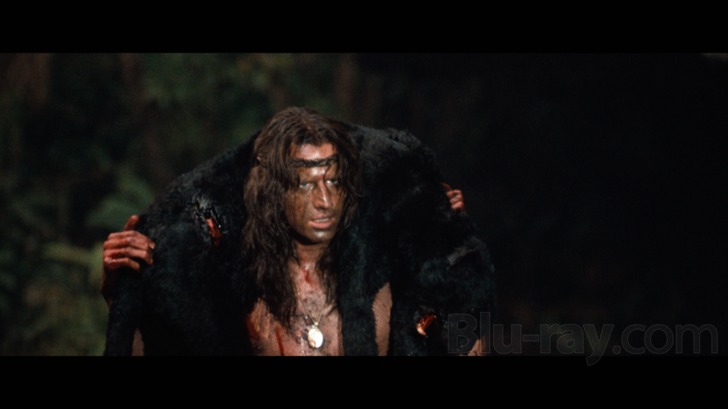
Greystoke was released in Dolby stereo on 35mm and also received a 70mm release with 6-track sound. Whatever source was used for the 5.1 mix presented on Blu-ray in lossless DTS-HD MA 5.1, the result provides excellent stereo separation across the front soundstage and a reasonably effective surround presence for a mix of this vintage that is most noticeable in the jungle sequences. The dynamic range is surprisingly wide, with bass extension that goes deep enough to add real impact to the angrier ape sounds and animal battles. The lushly classical score by John Scott (Wake in Fright) has room to breathe and is well suited to director Hudson's visuals.
Greystoke: The Legend of Tarzan, Lord of the Apes Blu-ray Movie, Special Features and Extras 
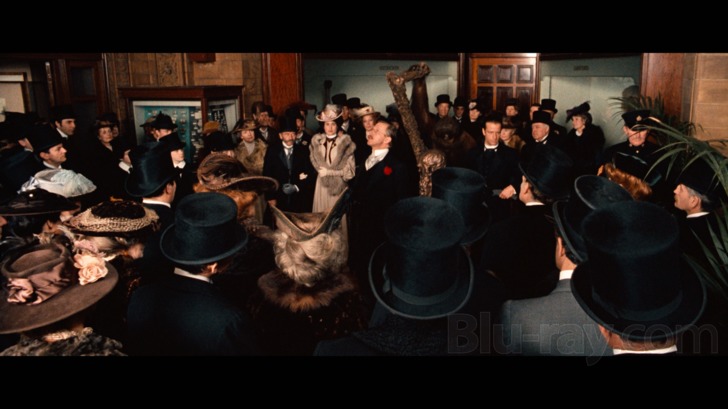
- Commentary with Director Hugh Hudson and Line Producer Garth Thomas: Hudson and Thomas provide substantial detail on the challenging logistics of the production in its various locales (primarily Scotland and Cameroon, but also London) and on elaborately constructed sets, but the commentary is most notable for what they don't say. There isn't a hint of any controversy over the script, not a word about Andie MacDowell's voice being replaced by Glenn Close (even though Hudson speaks at length about hiring MacDowell for her first movie role, the favorable response she elicited from the cast and crew, and her subsequent career), and not a clue about Hudson's participation, or lack thereof, in the restoration of the various scenes added back into the version on which they're commenting. Too much of the commentary devolves into narration of obvious plot points (e.g., the significance of the lighted windows at Greystoke manor going dark near the film's end—well, duh!).
- Trailer (480i; 2:40:1; 1:29).
Greystoke: The Legend of Tarzan, Lord of the Apes Blu-ray Movie, Overall Score and Recommendation 

Hudson says on the commentary that he was offered a sequel to Greystoke and turned it down. It's doubtful whether a sequel would have made it past development, even if Hudson had said yes. Burroughs wrote over twenty Tarzan novels, so that in theory numerous adventures remained for his famous character. But what adventures would be suitable for the character on whom the titles roll at the end of Hudson's film? It's not even clear who Johnny has become, except that he knows he's not an ape but also that he can never feel at home in English society (or perhaps even among humans). "Half of me is the Earl of Greystoke", says Johnny. "The other half is wild." As Hudson has told the story, it's much more than half that's wild. Recommended on its technical merits as a Blu-ray. The film is a matter of personal taste.
Similar titles
Similar titles you might also like

Mogambo
1953

King Solomon's Mines
Warner Archive Collection
1950

Tarzan's Three Challenges
Warner Archive Collection
1963

White Hunter, Black Heart
1990

Harry and Tonto
1974

Quigley Down Under 4K
1990

The Roots of Heaven
Limited Edition to 3000 - SOLD OUT
1958

Angel and the Badman
1947

Broken Arrow
1950

Campbell's Kingdom
1957

Tarzan's Greatest Adventure
Warner Archive Collection
1959

Tarzan Goes to India
Warner Archive Collection
1962

The African Queen
1951

Shout at the Devil
Special Edition
1976

The Ghost and the Darkness
1996

Sands of the Kalahari
4K Restoration
1965

Three Faces West
1940

The Purple Plain
1954

Botany Bay
1953

Jayne Mansfield's Car
2012
